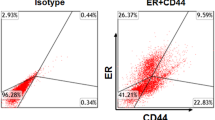Summary
The ex vivo labelling of DNA-synthesizing epithelial cells in colonic and vaginal mucosa was compared with in vivo labelling. For this purpose, in vivo S-phase cells were labelled with [3H]thymidine (Tdr) and ex vivo labelling was continued by culturing tissue specimens in bromodeoxyuridine (BrdU). Various methods of tissue culture were employed in order to improve diffusion of medium (and BrdU) in the tissue. BrdU and 3H-TdR labelling were evaluated by immunohistochemistry and autoradiography respectively. Ex vivo labelling resulted in a patchy distribution of labelled cells, which did not correspond with the 3H-TdR labelling pattern obtained in vivo. Under the described conditions ex vivo labelling does not appear to be a reliable for estimation of the proliferative activities in vivo.
Similar content being viewed by others
References
Averette HE, Weinstein GD, Frost P (1970) Autoradiographic analysis of cell proliferation kinetics in human genital tissues. Am J Obstet Gynecol 108:8–17
Chwalinski S, Potten CS, Evans G (1988) Double labelling with bromodeoxyuridine and [3H]thymidine of proliferative cells in small intestinal epithelium in steady state and after irradiation. Cell Tissue Kinet 21:317–329
Daemen M, Lombardi D, Goessens M, Bosman F, Schwartz S (1989) Comparison between continuous labeling with bromodeoxyuridine and 3H-thymidine in the balloon injured rat aorta. Proceedings of the 30th Dutch Federation Meeting, Abstr 122
Garcia RL, Coltrera MD, Gown AM (1989) Analysis of proliferative grade using anti-PCNA/cyclin monoclonal antibodies in fixed, embedded tissues. Am J Pathol 134:733–739
Gasinska A, Wilson GD, Urbanski K (1989) Labelling index of gynaecologic tumours assessed by bromodeoxyuridine staining in vitro using flow cytometry and histochemistry. Int J Radiat Biol 56:793–796
Goldstein DJ (1980) A microdensitometric method for the analysis of staining kinetics. J Microsc 119:331–343
Gratzner HG (1982) Monoclonal antibody to 5-bromo and 5-iododeoxyuridine: a new reagent for detection of DNA replication. Science 218:474–475
Heartlein MW, O'Neill JP, Pal BC, Preston RJ (1982) The induction of specific-locus mutations and sister-chromatid exchanges by 5-bromo- and 5-chloro-deoxyuridine. Mutat Res 92:411–416
Kamata T, Yonemura Y, Sugiyama K, Ooyama S, Kosaka T, Yamaguchi A, Miwa K, Miyazaki I (1989) Proliferative activity of early gastric cancer measured by in vitro and in vivo bromodeoxyuridine labeling. Cancer 64:1665–1668
Kleef EM van, Smits JFM, Mey JGR de, Cleutjens JPM, Lombardi DM, Schwartz SM, Daemen MJAP (1992) α1-Adrenoreceptor blockade reduces the angiotensin II-induced vascular smooth muscle cell DNA synthesis in the rat thoracic aorta and carotid artery. Circul Res 70:1122–1127
Liber HL, Call KM, Mascioli DA, Thilly WG (1985) Mutational and pseudomutational effects of 5-bromodeoxyuridine in human lymphoblasts. Mutat Res 151:95–108
Lipkin M, Newmark M (1985) Effect of added dietary calcium on colonic epithelial-cell proliferation in subjects at high risk for familial colonic cancer. N Engl J Med 313:1381–1384
Morstyn G, Kinsella T, Hsu S, Russo A, Gratzner H, Mitchell J (1984) Identification of bromodeoxyuridine in malignant and normal cells following therapy: relationship to complications. Int J Radiat Oncol Biol Phys 10:1441–1445
Morstyn G, Pyke K, Gardner J, Ashcroft R, Fazio A, Bhathal P (1986) Immunohistochemical identification of proliferating cells in organ culture using bromodeoxyuridine and a monoclonal antibody. J Histochem Cytochem 34:697–701
Raza A, Spiridonidis C, Ucar K, Mayers G, Bankert R, Preisler HD (1985) Double labeling of S-phase murine cells with bomodeoxyuridine and a second DNA-specific probe. Cancer Res 45:2283–2287
Schutte B, Reynders MMJ, Bosman FT, Blijham GH (1987) Studies with anti-bromodeoxyuridine antibodies. II. Simultaneous immunocytochemical detection of antigen expression and DNA synthesis by in vivo labeling of mouse intestinal mucosa. J Histochem Cytochem 35:371–374
Shrieve DC, Begg AC (1985) Cell kinetics of aerated, hypoxic and re-aerated cells in vitro using flow cytometric determination of cellular DNA and incorporated bromodeoxyuridine. Cell Tissue Kinet 18:641–651
Steel GG (1987) Growth kinetics of tumours. Clarendon Press, Oxford
Thornton JG, Wells M, Hume WJ (1988) Flash labelling of S-phase cells in short-term organ culture of normal and pathological human endometrium using bromodeoxyuridine and tritiated thymidine. J Pathol 154:321–328
Author information
Authors and Affiliations
Rights and permissions
About this article
Cite this article
Wanders, S.L., ten Kate, J., van der Linden, E. et al. Does ex vivo labelling of proliferating cells in colonic and vaginal mucosa reflect the S-phase fraction in vivo?. Histochemistry 98, 267–270 (1992). https://doi.org/10.1007/BF00271041
Accepted:
Issue Date:
DOI: https://doi.org/10.1007/BF00271041




